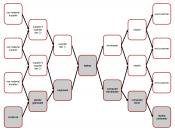Supply Chain Analysis � PAGE �1�
Supply Chain Analysis
EBUS 400 E-Business
Introduction
A supply chain operation, be it of a conventional sense, or one in the e-business setting, entails distribution of goods and services from the provider of said product to procurement by the customer. The various aspects of the supply chain in both the B2B and B2C community include making the product, housing or storing, allocation and the delivery of services and goods to customers and companies alike.
Supply Chain Analysis
The B2B supply chain operation is more multifaceted than its counterpart, primarily because B2B manufacturers, wholesalers and distribution entities are characteristically working with bigger partners in the business community. For supply chain operations to function efficiently in a B2B or B2C atmosphere, the focal point has to be on offering consumers exemplary customer service.
Quite a few parallels exist between supply chain operations for B2B and B2C settings.
Supply chain operations in B2B have to concentrate on a type of segmented market, made up of a wide variety of customers. This because B2B consumers usually have particular needs, such as consulting, etc.
Another difference in supply chain operations is B2C web sites have to make a practice of tracking the traffic levels that pass through the site, more so than B2B
Functioning in real time is imperative for B2C supply chain settings, primarily because this permits producers of goods to tweak transactions in a real time situation, a general request of larger retailing entities (Reese, 2004).
Other differences of B2B and B2Cs are the dependence on other means of supply by B2Cs. Catalogs, for instance, are an example of other types of supply methods that are used.
B2B supply chain operations enjoy a large market share in the U.S. by offering services such as commodities including...


